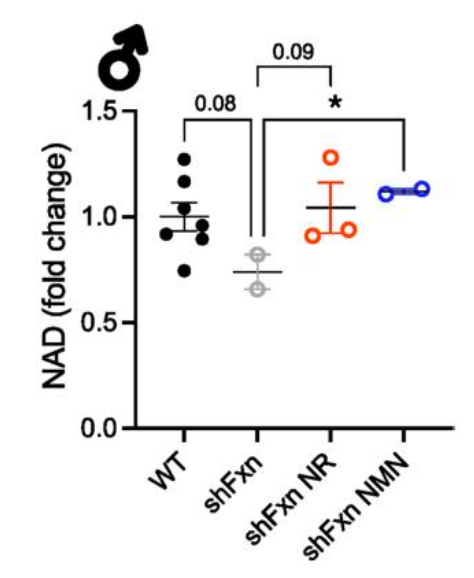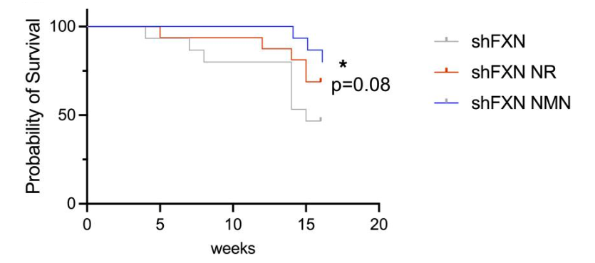This study examined the potential benefits of NMN and NR in a mouse model of Friedreich’s ataxia (FRDA), a neurodegenerative disease characterized by impaired motor function and heart problems.
Key Points:
NMN and NR provided several benefits in mice with FRDA and highlighted key differences between the two treatments:
- NMN more effectively restored NAD+ levels in the heart than NR
- Both NMN and NR extended survival, with NMN being the most effective
- NMN and NR modestly improved certain aspects of heart function
- Both treatments enhanced the glutathione antioxidant pathway
NMN and NR Evaluated in Mice with Friedreich’s Ataxia
A mouse model of FRDA (shFxn) was used to study the effects of NR and NMN.
These mice developed various symptoms similar to human FRDA, including loss of coordination, brain damage, muscle weakness, and enlarged hearts.
NR and NMN were administered in the drinking water of mice:
- NR: 3.0 mg/mL
- NMN: 3.5 mg/mL
Two groups of mice were used in the study. In the first group, both male and female mice were studied. However, due to observed differences between sexes, the second group focused only on male mice
NMN More Potent Than NR in Restoring Heart NAD+ Levels
Male mice with FRDA developed hearts that pumped harder and had abnormally thickened walls, which were slightly improved by NR and NMN treatment.
These mice also tended to have lower NAD+ levels in the heart, but NMN significantly boosted these levels, as shown in the graph below.

This graph shows that untreated mice with FRDA (gray dots) had much lower NAD+ levels in the heart compared to healthy mice (black dots). Treatment with NR (orange dots) slightly increased NAD+ levels, while NMN (blue dots) significantly boosted NAD+ in the heart tissue of FRDA mice.
“Male shFxn mice trended toward lower NAD+ levels in the heart tissue, with NR tending to increase and NMN significantly increasing NAD+.”
Males lost weight and showed decreased motor coordination, with no improvement from NR or NMN.
Small changes in glucose were observed, with NMN preventing some increases, but no significant effects on insulin levels.
The FRDA model revealed sex-specific differences; female mice had milder heart changes, maintained stable NAD+ levels, and showed better survival compared to males.
Survival Significantly Extended by NMN Treatment
Untreated male mice had a high early death rate, with less than half surviving past 16 weeks after the onset of FRDA.
However, supplementation with NAD+ precursors, particularly NMN, extended their lifespan.
The graph below illustrates this: the untreated mice (gray line) had the shortest survival, those treated with NR (orange line) lived somewhat longer, and mice treated with NMN (blue line) had the longest survival.

“Encouragingly, administration of NAD+ precursors prolonged survival in shFxn mice, with NMN alone or pooled data reaching statistical significance.”
Heart Function Shows Modest Improvement with NMN and NR
Mice with FRDA developed hearts that began to pump harder and had abnormally thickened walls.
When treated with NMN or NR, the thickening of the heart walls and increased pumping were less severe.
Although NMN and NR provided some benefit, they did not fully resolve the heart issues, and the heart’s function remained below optimal levels.
“Treatment with NR or NMN had only modest protective effects but seemed to limit the peak values for both the LVPW thickening and EF increases.”
NMN and NR Enhance a Key Antioxidant Pathway
Analysis of the heart tissue showed NR and NMN primarily boosted the glutathione pathway, an important antioxidant system in cells.
“The effects of NR and NMN treatment were mainly restricted to the glutathione synthesis pathway, suggesting that they might enhance an adaptive response to increase this antioxidant, which could lessen oxidative damage that occurs in FRDA.”
Conclusion
Male mice with FRDA had significantly shorter lifespans, but NAD+ precursors extended their survival, with NMN being the most effective.
“Our data suggest a benefit for NAD+-based therapeutics in the shFxn model, including an overall increase in survival among males.”
Treatment with NMN or NR reduced heart pumping issues and wall thickening caused by FRDA, but had little impact on other heart-related problems.
“NR or NMN administration had little effect on early cardiac abnormalities but limited the most extreme increases in left ventricular wall thickness and EF.”
The NAD+ precursors significantly boosted the glutathione antioxidant pathway, providing protection against free radical damage.
“Glutathione metabolism was the pathway most affected by NAD+ precursor administration.”
